Covering the refugee crisis
From the Greek island of Lesbos, to the sea between Thailand and Malaysia. From train tracks in Mexico to dusty camps in South Sudan and northern Nigeria.
Over the past year and a half, AFP has published scores of blogs on the refugee crisis all over the world, in which the agency's journalists recount covering the tragedy.
These are the stories that we have run since the start of 2015, a year that saw a million people flee to Europe alone, according to UN's refugee agency. We will update the page with new blogs as they are published, so make sure to check back.
'I've always hated waiting and now that's all I do'
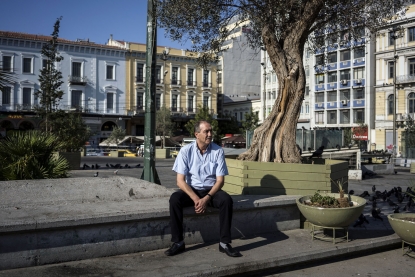 (AFP / Angelos Tzortzinis)
(AFP / Angelos Tzortzinis)As part of our comprehensive coverage of the refugee crisis, AFP reporters are following a handful of refugees at different stages of their journeys toward Europe. You can read about the young Iraqi couple waiting on asylum in The Netherlands here.
This is a story of Moufid, a restaurant owner from the Syrian city of Aleppo, who is waiting for a new beginning in Greece.
August 29, 2016
Where are the hashtags now?
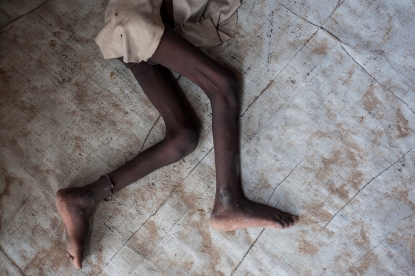 (AFP / Stefan Heunis)
(AFP / Stefan Heunis)"It may be the rainy season, but the savannah scrubland stretching out below me is dusty, dry and brown, linked by a spider’s web of dirt tracks and footpaths," writes Stefan Heunis of his trip to Maiduguri, northeastern Nigeria to report on the latest calamity to befall the region
Severe food shortages mean that tens of thousands of children whose families fled Boko Haram violence are now in danger of starving to death.
July 27, 2016
The interview
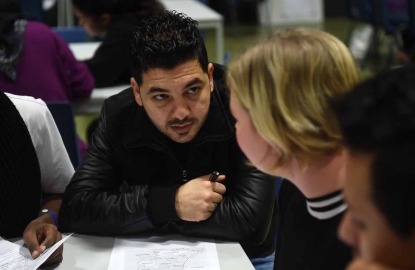 (AFP / Emmanuel Dunand)
(AFP / Emmanuel Dunand)In the latest instalment on her series of blogs on an Iraqi refugee family, Serene Assir lets Ahmad describe his long-awaited asylum interview in The Netherlands.
"I had my asylum interview in mid-March. We had been waiting for so long to get the chance to tell our story to the Dutch authorities, that when the day finally came, I was very nervous. I knew my whole life, and our fate as a family was going to be determined by this one interview."
July 26, 2016
Aboard the Aquarius
In May, AFP's deputy bureau chief in Rome Fanny Carrier spent a week aboard the Aquarius, one of a small armada of ships that are rescuing migrants all along the Libyan coast, writing a three-part series on her voyage:
'If we don't go, how many will die?'
 (AFP / Gabriel Bouys)
(AFP / Gabriel Bouys)The Aquarius has a rendez-vous. We don’t yet know exactly with whom, or when, but we have a vague idea of where. A long stretch of sea along the Libyan shore.
June 8, 2016
'Here we are alive. There, we were no longer men.'
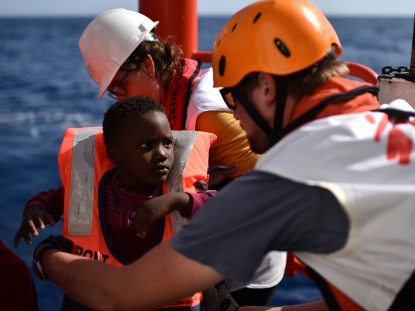 (AFP / Gabriel Bouys)
(AFP / Gabriel Bouys)The next morning, I wake up shortly after sunrise. We have arrived at our destination, about 20 nautical miles off the Libyan coast. The ship has stopped. We wait.
June 9, 2016
'We have a boy!'
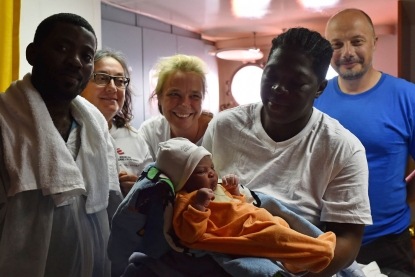 (AFP / Gabriel Bouys)
(AFP / Gabriel Bouys)Again, I wake up with the sun. Angelina the midwife has been up for a while -- a woman eight months pregnant has had contractions during the night. On deck, the mood has changed sharply. After some sleep, the migrants are much cheerier. The children play, some couples snuggle. Most have put their white rescue jumpsuits on top of their clothes. Others have thrown out their clothes, many dirty from vomit, and have wrapped their blankets around their waists and the towels around their heads.
June 10, 2016
The pianist of Yarmouk in his new land
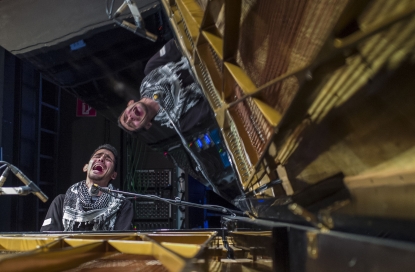 (AFP / John MacDougall)
(AFP / John MacDougall)"It was the only thing Aeham Ahmad saw when he entered the room," writes AFP's Berlin-based correspondent Yannick Pasquet.
"A shiny Bechstein piano on which he would play in a few hours, on a Berlin stage aptly named 'The Home Port.'"
May 20, 2016
Ticket to Lesbos

"Gotta book a ticket to Lesbos, my bureau chief says it can't wait any longer," writes Athens-based videographer Will Vassilopoulos.
"It’s April 2015 and a ship carrying 400 migrants from the island of Lesbos had docked the previous day at the port of Piraeus. Something is happening in Lesbos and I have to check it out immediately."
April 25, 2016
Losing their minds
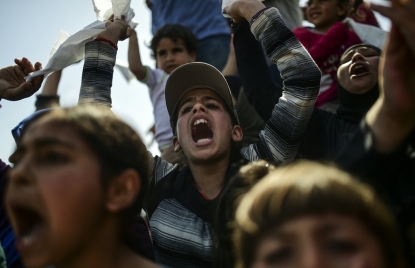 Migrants and refugees protest to open border gate at their makeshift camp in the northern Greek border village of Idomeni, April 6, 2016. (AFP / Bulent Kilic)
Migrants and refugees protest to open border gate at their makeshift camp in the northern Greek border village of Idomeni, April 6, 2016. (AFP / Bulent Kilic)"The striking thing about these refugees, the ones stuck for months on the Greece-Macedonia border, is that you can actually feel them slowly losing their minds," writes AFP's chief photographer for Turkey Bulent Kilic.
"I’ve covered this refugee crisis for years and in all sorts of places -- the refugees fleeing the war inside Syria, getting out of the war zone through barbed wire at the Turkish border, reaching European shores after dangerous journeys at sea on the Greek island of Lesbos. And now here in the Greek village of Indomeni, near the border with Macedonia."
April 18, 2016
Passengers with problems
 Plainclothes Turkish police officers check passengers' passports at the international airport in Istanbul on January 29, 2015. ((AFP / Ozan Kose))
Plainclothes Turkish police officers check passengers' passports at the international airport in Istanbul on January 29, 2015. ((AFP / Ozan Kose))"Mohammed K. is in a Kafkaesque situation -- for the past five months this refugee from Syria has been stuck in a no-man’s land at an Istanbul airport, unable to enter the country, but unable to leave," writes AFP correspondent Herve Bar, who found himself with Mohammed for a day in a room for "passengers with problems."
April 4, 2016
Haunted by his eyes
 The funeral. ( (AFP / Wakil Kohsar))
The funeral. ( (AFP / Wakil Kohsar))"In my seven years with AFP, I have witnessed plenty of human cruelty," write's AFP's Kabul-based correspondent Guillaume Decamme. "But nothing, not even the bloodied bones of Iraqis on the pavement following bombings, could have prepared me for what I and AFP photographer Wakil Kohsar saw on Saturday, March 12."
March 21, 2016
Waiting for the gate to open
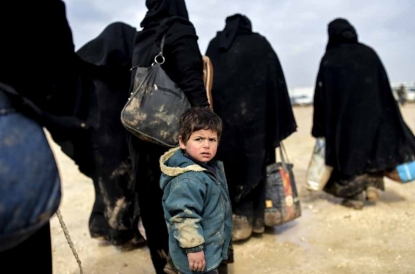 February, 2016. ((AFP / Bulent Kilic))
February, 2016. ((AFP / Bulent Kilic))"It’s just crazy that this is still happening. Five years and it’s still happening. Five years that you have this war in Syria. And today you again have thousands of people massed on the border with Turkey," writes AFP's Istanbul-based photographer Bulent Kilic.
"These people, they know how to run. They’ve been running for the past five years and now it’s time to run again. So they’ve picked up and they’ve run. And now they’re just waiting for the gate to open.
"And you can’t imagine the conditions these people are living in right now.... there are children everywhere. Every family has two to three children. The whole place is full of children.... It’s heartbreaking to see kids in these conditions."
February 9, 2016
Abandoned to anarchy in Calais
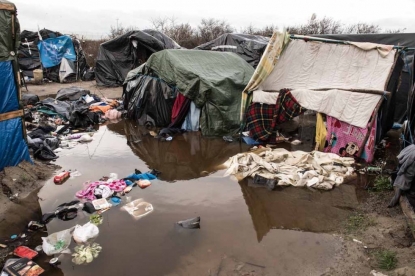 The Jungle. January, 2016. ((AFP / Philippe Huguen))
The Jungle. January, 2016. ((AFP / Philippe Huguen))"To spend time in the Jungle -- the infamous migrant camp on the edge of the French port of Calais -- is to visit a place where thousands have been abandoned to anarchy," writes AFP's Paris-based journalist Eric Randolph.
"People hunting the dream of a better life in Britain have been coming here for decades -- at least since the completion of the Channel Tunnel in 1994 gave the illusion that one could simply walk to the shores of Dover."
"As security has tightened and the crossing has become ever harder, the population of the Jungle has swelled and the camp has taken on a semi-permanent feel... and the Jungle has become -– quite by accident -- an experiment in anarchic governance."
February 3, 2016
What if this baby were mine?
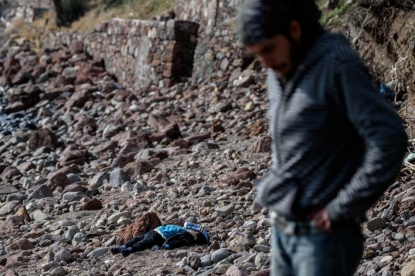 A man stands next to the body of a migrant child washed up on a turkish beach on January 30, 2016. ((AFP / Ozan Kose))
A man stands next to the body of a migrant child washed up on a turkish beach on January 30, 2016. ((AFP / Ozan Kose))"The baby is the first dead body I see when I get to the beach. He looks like he is nine or ten months old. He is dressed warmly and was wearing a hat. An orange pacifier is attached to his clothes," writes AFP's Istanbul-based photographer Ozan Kose, who took pictures of a Turkish beach the morning after a boat overloaded with refugees seeking a better life in Europe sank off shore.
"For the moment, noone is taking care of the dead baby. I return to him and stay there, for about an hour, silent. I have a baby boy who is five months and a daughter who is eight years old. I ask myself what I would do if this were my baby."
February 1, 2016
Exodus under the Balkan snow
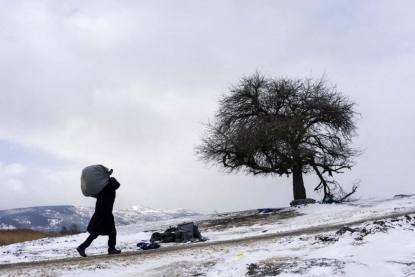 ((AFP / Dimitar Dilkoff))
((AFP / Dimitar Dilkoff))"With the cold and snow that descend on the Balkans in the winter, the number of refugees trekking the so-called Balkan migrant route has dwindled from the sea of humanity that made the journey each day in the summer and autumn," writes AFP's Bulgaria-based photographer Dimitar Dilkoff.
"But they are still coming, walking on foot through the freezing cold and snow."
January 28, 2016
Refugee influx divides Germany
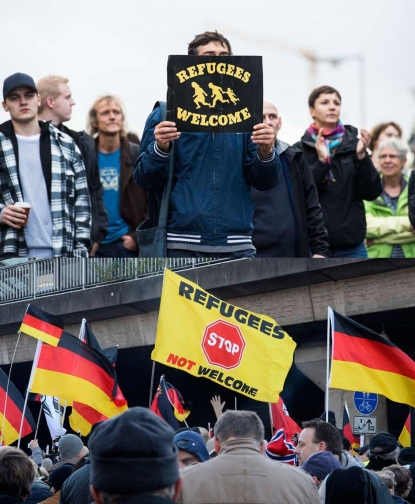 (Top: (AFP / John Macdougall) / Bottom: (AFP / Roberto Pfeil))
(Top: (AFP / John Macdougall) / Bottom: (AFP / Roberto Pfeil))"Safe, prosperous Germany just had a mad year, when a ground-breaking influx of over one million asylum seekers sparked sky-high hopes and rekindled deep-seated fears," writes AFP's Berlin-based correspondent Frank Zeller.
"The New Year, at the stroke of midnight, shaped up to be 2015 Reloaded, or worse. Will this be the year when German Angst makes an ugly comeback?
"The entire country is asking the same question. And so far, the signs are mixed."
January 21, 2016
Dear Adam: New Year, new life for refugees like you
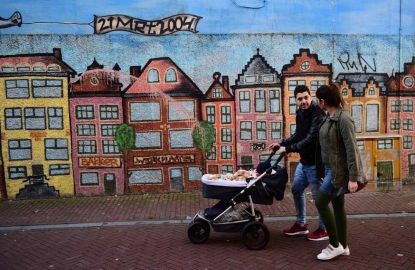 Ahmad and Alia take Adam for a walk. ((AFP / Emmanuel Dunand))
Ahmad and Alia take Adam for a walk. ((AFP / Emmanuel Dunand))"Dear Adam,
"I first met you when you were just three months old, a baby in your father's arms as he and your beautiful mother climbed onto an old, packed train on the Balkan migrant route to Europe," writes AFP's Paris-based correspondent Serene Assir.
Having survived a bomb attack in their native Baghdad, Adam's parents, Ahmad and Alia, decided to risk it all to give their son a life in peace and security. They took their life savings and headed to the promised land of Western Europe. They crossed the Aegean Sea, a drop in the tide of humanity that last year made the often perilous journey, fleeing misery and warfare in their homelands. They trekked the Balkan migrant route, where Serene, photographer Aris Messinis and videographer Celine Jankowiak first met them. Eventually they ended up in the Netherlands, where they have applied for asylum.
"Because you've had such an incredible start to life, I decided to write you this letter to start the New Year.
"I'll ask your parents, who moved mountains to bring you to Europe, to keep it safe so you can read it when you're older."
January 6, 2016
Working in the shadows, putting a spotlight on the world
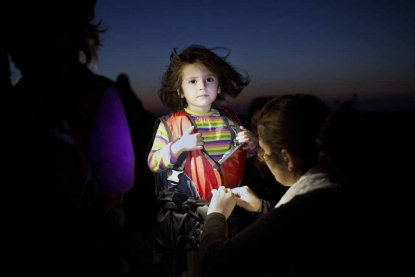 Kos. August, 2015. ((AFP / Angelos Tzortzinis))
Kos. August, 2015. ((AFP / Angelos Tzortzinis))This year’s winner of Time Magazine’s Best Wire Photographeraward is Angelos Tzortzinis, a 31-year-old freelancer who has been contributing pictures to AFP as a stringer since 2007. The magazine chose Tzortzinis “for his heartfelt work” in documenting his country’s response to the unprecedented financial and migrant crises.
Reserved by nature, Tzortzinis picked up photography on a lark, but quickly became enthralled with it and has stuck with it in part because it offered a means of communicating with others. He is a bit uneasy with the spotlight since winning the award.
“I prefer to remain in the shadows as I work,” he writes. “The prize has given me a boost of hope and energy to continue my work.
“It’s also great motivation for freelancers, who have to struggle every day… The fact that a freelancer won such a prestigious prize in Greece will give other stringers hope and encouragement to continue.”
December 30, 2015
War in peace
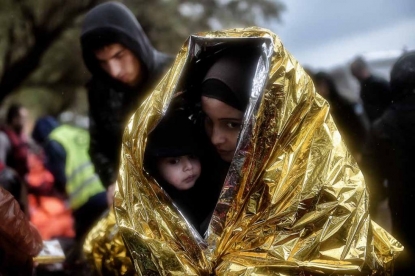 Children huddle under emergency blankets after arriving in Lesbos in October, 2015. ((AFP / Aris Messinis))
Children huddle under emergency blankets after arriving in Lesbos in October, 2015. ((AFP / Aris Messinis))AFP's chief photographer in Greece Aris Messinis knows what a war looks like. He's covered conflicts in Syria and Libya. He has seen death and suffering. But covering the migrants arriving in their hundreds on the shores of the Greek island of Lesbos has affected him more.
"You constantly realize that you're not in a warzone. That you're working in a place where there is peace... the human pain is the same as in a war, but just knowing that you are not in a warzone makes it much more emotional. And much more painful."
November 6, 2015
The rape camps of South Sudan
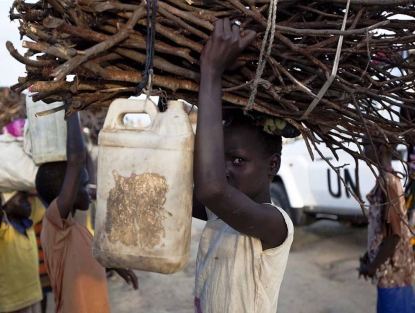 A young woman carries firewood at a UN base outside Bentiu. ((AFP / Tristan McConnell))
A young woman carries firewood at a UN base outside Bentiu. ((AFP / Tristan McConnell))In April-July this year, as civil war raged in the world’s youngest nation South Sudan, reports began trickling that atrocities were being committed by government soldiers and their allied militias in the northern Unity State. Aid agencies produced alarming reports of attacks that shared the common feature of women being raped, often by more than one armed man.
Tristan McConnell, an AFP correspondent based in Nairobi who has been visiting South Sudan for a decade, went to Unity to investigate. Dozens of interviews produced what appeared to be a clear pattern of abuse – women were abducted, kept tied up and under guard and at night raped repeatedly, often by groups of men.
It appeared systematic, organised and planned. “Rape camps” seemed the only appropriate description.
October 7, 2015
Taking pictures in the Calais 'Jungle'
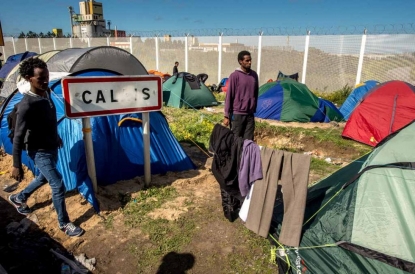 ((AFP / Philippe Huguen))
((AFP / Philippe Huguen))The French town of Calais has been a magnet for refugees and migrants trying to reach Britain ever since the Channel Tunnel opened in 1994, allowing trains and automobiles to race under the waters.
Until recently, the migrants arrived in the region, stayed a bit and moved on, most of them finding one way or another to sneak across the waters into England.
But lately the authorities have made stealing across the waters more and more difficult and a bottleneck has developed – the migrants already here can’t find a way across and more keep arriving.
Today they live in an area dubbed the “Jungle” – a small town of tents and shacks. AFP’s photographer in the nearby city of Lille,Philippe Huguen, has been photographing the migrants in Calais for more than 15 years. Here he shares what’s it like taking pictures in the Calais “Jungle.”
October 1, 2015
A long walk to freedom
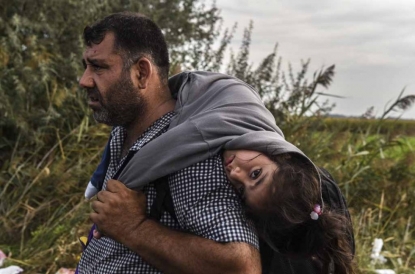 Refugees cross the Hungarian-Serbian border on September 14, 2015. ((AFP / Armend Nimani))
Refugees cross the Hungarian-Serbian border on September 14, 2015. ((AFP / Armend Nimani))"A little Syrian boy appears between the legs of a line of Hungarian police. He grips a dirty plastic bag of bread rolls and is clearly lost", writes AFP reporter Helen Percival. "Standing in the rain, he quietly looks up at the officers. The police gesture to a family climbing on a nearby bus headed to a migrant camp, asking if he belongs to them. They firmly shake their heads and move on."
"All the while, in the shoving and confusion, the little boy looks on as the rain falls. With barely any hesitation, the police lift the boy onto the bus, the doors close and the bus pulls away."
"That was 45 seconds at Röszke migrant collection point in Hungary."
September 23, 2015
A journey to the unknown on the Balkan migrant route. Part 2
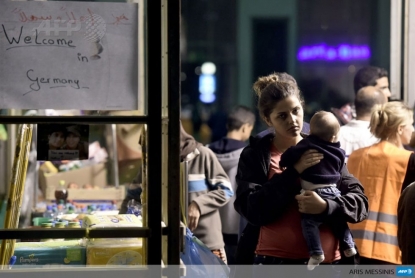 ((AFP / Aris Messinis))
((AFP / Aris Messinis))"Since the beginning of 2015, more than 350,000 people fleeing war and misery have reached Europe in risky, sometimes deadly journeys on inflatable boats", writes AFP reporter Serene Assir."They set sail from Turkey's shores for Greece and from chaos-ridden Libya for Italy. Most are Syrians, Iraqis and Afghans, desperate to restart their lives in safety".
"But they face a journey plagued with obstacles, smugglers and hustlers, long waits in the sun and short nights in the cold before they get there. They also face many fears and exorbitant costs, which they cover with money borrowed from family or from having sold their homes."
"After covering the refugees' ordeal on the Greek islands, AFP has sent a team of three journalists on the Balkan migrant route to follow the continuation of their journey to an all too uncertain future."
"This is a diary with notes from the trip from Greece through Macedonia, Serbia and Hungary. Our plan is to reach Germany with the migrants."
(Part 2 starts on the 4th day of the journey, at the Serbia-Hungary border).
September 9, 2015
A starting point for refugees' dreams... and nightmares
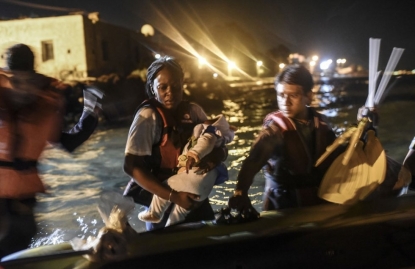 A woman and her baby board a dinghy to reach the Greek Island of Kos from Bodrum, Turkey, on August 20, 2015. ( (AFP / Bulent Kilic))
A woman and her baby board a dinghy to reach the Greek Island of Kos from Bodrum, Turkey, on August 20, 2015. ( (AFP / Bulent Kilic))"Usually in summer, Bodrum is known as a glitzy destination for Turkish celebrities and moneyed Istanbulites, its upmarket nightclubs and golden sands earning it the moniker of the Turkish Saint Tropez", writes AFP reporter Fulya Özerkan. "But this year, with the summer holiday season in full swing, the Bodrum peninsular has become a launch point for refugees making the open boat journey from Turkey to the EU and the Greek island of Kos, tantalisingly visible to the south".
"Some will make it to Greece to have a chance of forging a new life in the European Union. But, for others, the shiny resort will turn into a trap they cannot leave".
"And several won't make it out alive".
September 4, 2015
A journey to the unknown on the Balkan migrant route. Part 1
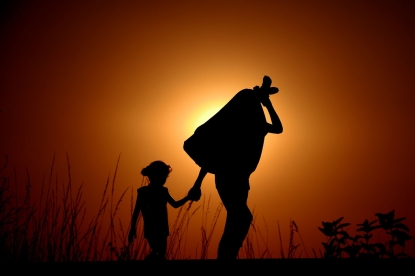 Syrian refugees and migrants try to cross from Serbia into Hungary, September, 2015. (AFP / Aris Messinis)
Syrian refugees and migrants try to cross from Serbia into Hungary, September, 2015. (AFP / Aris Messinis)"Since the beginning of 2015, more than 350,000 people fleeing war and misery have reached Europe in risky, sometimes deadly journeys on inflatable boats", writes AFP reporter Serene Assir."They set sail from Turkey's shores for Greece and from chaos-ridden Libya for Italy. Most are Syrians, Iraqis and Afghans, desperate to restart their lives in safety".
"But they face a journey plagued with obstacles, smugglers and hustlers, long waits in the sun and short nights in the cold before they get there. They also face many fears and exorbitant costs, which they cover with money borrowed from family or from having sold their homes."
"After covering the refugees' ordeal on the Greek islands, AFP has sent a team of three journalists on the Balkan migrant route to follow the continuation of their journey to an all too uncertain future."
"This is a diary with notes from the trip from Greece through Macedonia, Serbia and Hungary. Our plan is to reach Germany with the migrants."
(Part 1 covers the journey from Greece to Belgrade).
September 4, 2015
'The lucky ones'
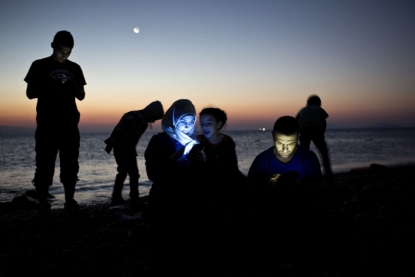 Migrants check their mobile phones on a beach after reaching the Greek island of Kos on August 12, 2015. ((AFP / Angelos Tzortzinis))
Migrants check their mobile phones on a beach after reaching the Greek island of Kos on August 12, 2015. ((AFP / Angelos Tzortzinis))"It’s 4:00 am, stars fill the velvet night sky and the Aegean Sea is perfectly still", writes AFP reporter Serene Assir. "A few journalists gather at the beach in Greece’s resort island Kos, waiting in silence on an unlikely frontline of Europe’s worst migration crisis since World War II. Today, like every other day, scores of refugees and migrants fleeing war and misery will reach the shore on inflatable boats, dreaming of a better life in Europe."
“Greece? Turkey? Where am I?” pants a man in his forties as he clambers out of the dinghy, tearing off his bright orange life vest. “You’re in Greece,” I reply. Overcome with emotion, he kneels down on the sand to pray, grateful that he has made it to Europe alive."
August 28, 2015
Dreams crushed by a beast
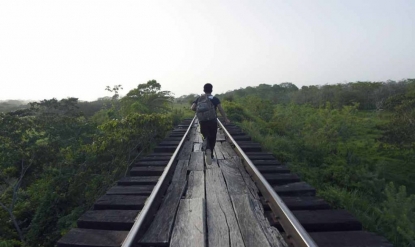 A migrant runs to catch a train in the Chacamax community of Chiapas State, Mexico, on June 21, 2015. ( (AFP Photo / Alfredo Estrella))
A migrant runs to catch a train in the Chacamax community of Chiapas State, Mexico, on June 21, 2015. ( (AFP Photo / Alfredo Estrella))"It is 35 degrees out, and the humidity is close to 100 percent. We are tracking a freight train known as “La Bestia” (The Beast), as it rumbles from the southern border of Mexico towards the United States," writes Daphné Lemelin. "This train is part of the history of migration. Hundreds of thousands have ridden it in pursuit of their American dream. Many have been attacked, robbed, mutilated or even killed in the process."
July 28, 2015
A rail ticket to Europe
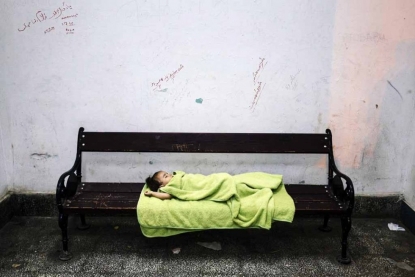 The baby of Syrian migrants sleeps in a train station waiting room in the southern Serbian town of Presevo on July 16, 2015. ( (AFP / Dimitar Dilkoff))
The baby of Syrian migrants sleeps in a train station waiting room in the southern Serbian town of Presevo on July 16, 2015. ( (AFP / Dimitar Dilkoff))"Early this month my work took me from Sofia to the far east of Bosnia for the anniversary of the 1995 Srebrenica massacre," writes the photographer Dimitar Dilkoff. "Before heading home I took the chance to stop in Serbia and see for myself the migration of hundreds of people heading north towards the European Union."
"Most of these migrants come from Muslim countries and many in the Balkans say they are terrorists. That, in any event, is the fantasy, what people imagine from afar. Because when you see these people it is plain – to me anyway – that they are just ordinary families making a long and difficult journey."
July 22, 2015
Fleeing through the eye of a needle
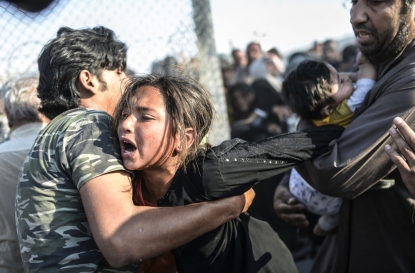 Syrians fleeing the war rush through broken down border fences to enter Turkish territory, near the border crossing at Akcakale in Sanliurfa province on June 14, 2015. ((AFP / Bulent Kilic))
Syrians fleeing the war rush through broken down border fences to enter Turkish territory, near the border crossing at Akcakale in Sanliurfa province on June 14, 2015. ((AFP / Bulent Kilic))"We have been on the Turkey-Syria border for a week now, within sight of Tal Abyad where Kurdish forces are battling Islamic State jihadists for control," writes AFP's Bulent Kilic. "On Sunday, June 14, thousands of people fleeing the fighting suddenly appeared from behind the hill and swarmed down towards the border fence. Everything happened in five minutes. It was like a Hollywood film."
"I have been photographing this refugee crisis for nearly four years now, but yesterday was different. Almost every woman had children with her. I have never seen anything like it."
June 15, 2015
Cycling to a better life
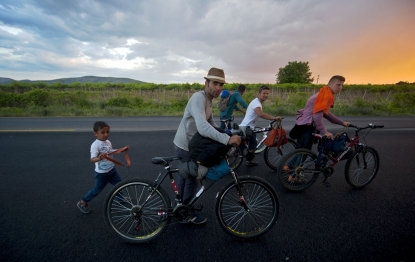 Migrants arriving from Greece walk on a highway near the town of Veles on their way to Macedonia's border with Serbia on June 9, 2015. ((AFP Photo / Robert Atanasovski))
Migrants arriving from Greece walk on a highway near the town of Veles on their way to Macedonia's border with Serbia on June 9, 2015. ((AFP Photo / Robert Atanasovski))"We have our fair share of problems here in Macedonia. The country is in deep political crisis," writes the photographerRobert Atanasovski. "Alongside this another crisis, a humanitarian one, is playing out day by day on the main road running north to south through the country, along the Vardar valley."
"For thousands of destitute people, the road is a passageway towards what they hope will be a better life in one of the countries of the European Union."
June 11, 2015
‘Somehow, they made it’
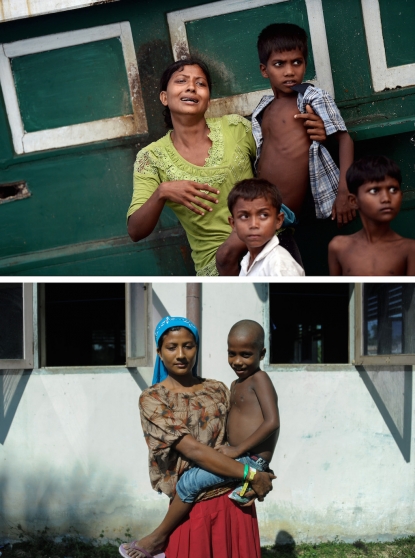 Rohingya migrant Ronji, 21, and her six-year-old son on a boat drifting off Thailand on May 14, 2015 and at a camp in Indonesia's Aceh province on May 24, 2015 ( (AFP / Christophe Archambault / Chaideer Mahyuddin))
Rohingya migrant Ronji, 21, and her six-year-old son on a boat drifting off Thailand on May 14, 2015 and at a camp in Indonesia's Aceh province on May 24, 2015 ( (AFP / Christophe Archambault / Chaideer Mahyuddin))On May 14, AFP's Christophe Archambault photographed a boat adrift off the coast of Thailand with 400 starving migrants on board, most of them members of the persecuted Rohingya minority from Myanmar. A week later, the vessel reached the coast of Indonesia's Aceh province, where his photographer colleagues Romeo Gacad and Chaideer Mayhuddin were finally able to put names to the faces captured in his dramatic images.
June 1, 2015
From one nightmare to another
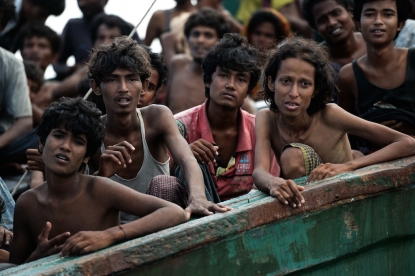 Rohingya migrants adrift in the Andaman Sea, off the southern Thai island of Koh Lipe, on May 14, 2015. ( (AFP / Christophe Archambault))
Rohingya migrants adrift in the Andaman Sea, off the southern Thai island of Koh Lipe, on May 14, 2015. ( (AFP / Christophe Archambault))"We are here in the hope our pictures can put a human face on this crisis," writes the AFP photographer Christophe Archambault, who travelled to the Andaman Sea to find a boat carrying hundreds of migrants from the persecuted Rohingya minority, adrift off the Thai coast. "My first reaction is shock. Their faces are completely emaciated. You can see their ribcages, their pointed shoulder bones. We are witnessing a situation of absolute horror."
May 15, 2015
When the big boat comes too late
 ( (AFP / Alberto Pizzoli))
( (AFP / Alberto Pizzoli))"Migrant landings in the ports of southern Italy follow a well-worn pattern," writes AFP's Fanny Carrier, who was in Sicily this month to report on the deadliest week in the Mediterranean migrant crisis. "Out on the ship’s deck, the men, women and children sit surrounded by rescuers and humanitarian workers in white protective suits, gloves and masks. Their stories are all similar, all harrowing. They tell of a fraught, ruinously expensive journey across Africa, the perilous crossing of the Sahara, their arrival in Libya. They tell of the violence of militias and people-smugglers. They tell of their fear on board the boat, of water seeping in, of the rescuers who barely reached them in time. And finally, of reaching a safe shore."
April 30, 2015
Across the water from Yemen
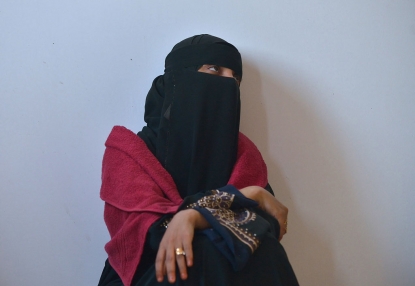 A Yemeni refugee at a UNHCR facility in Djibouti, April, 2015. ((AFP / Tony Karumba))
A Yemeni refugee at a UNHCR facility in Djibouti, April, 2015. ((AFP / Tony Karumba))In the fishing port of Obock, in Djibouti, hundreds of people fleeing the Saudi-led air war on Yemen have been landing in skiffs at all hours of the day and night.
"I photograph the sweet smiles of the young, the questioning looks of teenagers and the deep, reserved glances of their elders. I try to work as sensitively as I can, to capture the emotions on their faces," writes AFP photographer Tony Karumba. "But as always when I am documenting someone else's pain, reporting on the nightmare their lives have become, at the back of mind there is a bleak awareness my work can make little difference to their plight."
April 16, 2015
Boko Haram, through the eyes of children
 Young Nigerian refugees draw at a UNICEF refugee camp near Baga Sola, April, 2015. ((AFP / Philippe Desmazes))
Young Nigerian refugees draw at a UNICEF refugee camp near Baga Sola, April, 2015. ((AFP / Philippe Desmazes))"We are on the shores of Lake Chad in the Dar-es-Salam refugee camp, a dusty, crowded site sheltering some 5,000 people who fled over the border from northern Nigeria to escape the Boko Haram insurgency," writes AFP photographer Philippe Desmazes. "Among them are a great many children. Under a large white tent UNICEF has been holding art therapy workshops for young refugees. It’s a common technique used to help children in war zones overcome their trauma - and also a way to fill the endless days in the camp."
April 13, 2015
The day everything bright turned black
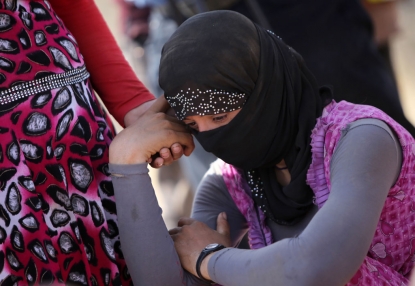 A Yazidi Iraqi woman in the Bajid Kandala camp in Kurdistan's western Dohuk province on August 13, 2014. ((AFP / Ahmad Al-Rubaye))
A Yazidi Iraqi woman in the Bajid Kandala camp in Kurdistan's western Dohuk province on August 13, 2014. ((AFP / Ahmad Al-Rubaye))
Threatened with rape, sexual slavery or forced marriage as the Islamic State group overran their homes last year, they fled at a moment's notice, leaving their lives behind. In early March, a dozen Yazidi and Christian women refugees in Arbil, Iraqi Kurdistan, took part in a workshop organised by the charity Chime for Change and hosted by journalists Mariane Pearl and Randa Habib. The goal was to teach them how to use narrative techniques to help share their terrible stories.
"I put my journalistic habits to one side, instead following my gut-feeling and intuition," writes Randa Habib. "This isn’t about extracting from these women good stories to print. It’s about making them feel comfortable, creating a bond that will enable them to tell me painful, private things. Simply because it will do them good."
"Their stories, when they share them at last, will stay with me for a long time."
March 16, 2015
Killing in a media blackout
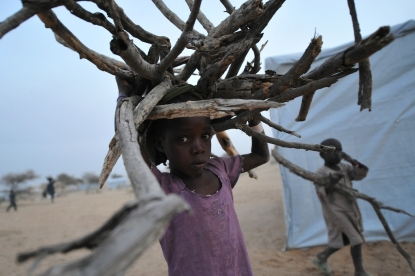 A child carries wood at a refugee camp near Lake Chad, January 2015.
((AFP / SIA KAMBOU))
A child carries wood at a refugee camp near Lake Chad, January 2015.
((AFP / SIA KAMBOU))"This week my colleague Celia Lebur travelled to Chad's border with Nigeria to hear the tales of men and women who escaped what may be the worst atrocity in Boko Haram's six-year Islamist insurgency, the assault on Baga," writes AFP's bureau chief in Lagos, Phil Hazlewood. "The harrowing stories add to mounting eye-witness accounts that we've already been able to gather from Nigeria, pointing at killings on a mass scale in Baga. But the numbers - even now, a month later - are impossible to verify."
January 30, 2015





